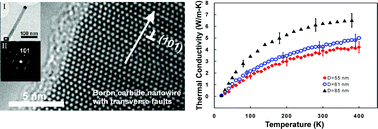Boron carbidenanowires: low temperature synthesis and structural and thermal conductivity characterization†
Abstract

* Corresponding authors
a
Department of Mechanical Engineering and Engineering Science, The University of North Carolina at Charlotte, Charlotte, NC 28223, USA
E-mail:
ttu@uncc.edu
b
Department of Mechanical Engineering, Vanderbilt University, Nashville, TN 37235, USA
E-mail:
deyu.li@vanderbilt.edu
c Advanced Technology Center, Lockheed Martin Space System Company, Palo Alto, CA 94304, USA

 Please wait while we load your content...
Something went wrong. Try again?
Please wait while we load your content...
Something went wrong. Try again?
Z. Guan, T. Gutu, J. Yang, Y. Yang, A. A. Zinn, D. Li and T. T. Xu, J. Mater. Chem., 2012, 22, 9853 DOI: 10.1039/C2JM14857A
To request permission to reproduce material from this article, please go to the Copyright Clearance Center request page.
If you are an author contributing to an RSC publication, you do not need to request permission provided correct acknowledgement is given.
If you are the author of this article, you do not need to request permission to reproduce figures and diagrams provided correct acknowledgement is given. If you want to reproduce the whole article in a third-party publication (excluding your thesis/dissertation for which permission is not required) please go to the Copyright Clearance Center request page.
Read more about how to correctly acknowledge RSC content.
 Fetching data from CrossRef.
Fetching data from CrossRef.
This may take some time to load.
Loading related content
